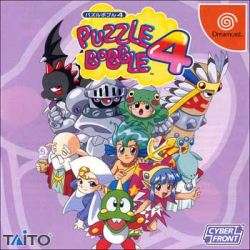Puzzle Bobble 4
| Puzzle Bobble 4 | |
|---|---|
 Japanese Dreamcast cover art | |
| Developer(s) | Taito Corporation |
| Publisher(s) |
Taito Corporation
|
| Director(s) | Kazuhiro Ohara |
| Designer(s) | Seiichi Nakakuki |
| Programmer(s) |
|
| Composer(s) | Rimiko Horiuchi |
| Platform(s) | Arcade, PlayStation, Game Boy Color, Microsoft Windows, Dreamcast |
| Release |
Arcade
|
| Genre(s) | Puzzle game |
| Arcade system | Taito F3 System |
Puzzle Bobble 4 (also known as Bust-a-Move 4 in North America and Europe) is the third sequel to the video game Puzzle Bobble and is the final appearance of the series on the arcade, PlayStation and Dreamcast.
Building upon the success of Puzzle Bobble 3, the game adds a pulley system that requires two sets of bubbles, attached to either side of a rope hanging across two pulleys. The game contains a story mode for single player play.
In total, the game features 640 levels. The console version features a level editor to either create and save a level, set a succession of levels, or to create an unlimited amount of extra levels and stages. It also has an alternative "story mode".
Story
On the planet Bubbleluna lives the twins Bub and Bob. One day, the sun fails to rise because the Fairy of the Night, Cleon, has stolen the light source known as the Rainbow for Full-Moon Madame Luna. She splits this rainbow into 7 light bubbles. Bub and Bob then set off to retrieve these bubbles and restore the light and peace to their planet.
Gameplay
This installment of the series introduces two new features: the pulley system and chain reactions. The pulley system consists of two groups of bubbles attached to either side of a pulley. Popping some on one side will cause that side to be "lighter" and therefore rise. The other side lowers in response. If a pulley is shaking and a bubble is attached, the resulting heavier side will lower. This requires added strategy to prevent one side from moving too far and therefore losing the game. One possible strategy is to form a bubble cluster between two pulleys to prevent them from lowering or rising at all. Then the player can triangulate until acquiring the necessary bubbles to clear both anchor bubbles, while still keeping both ends of the pulley clustered together.
Chain reactions occur only on the two player (or player and CPU) modes. When a bubble is dropped, it can move to another place on the board if this causes more bubbles to pop. If this, in turn, causes more bubbles to drop, then the chain reaction can continue.
Play Modes
- Puzzle Mode consists of a field of stages labelled A-Z, in a triangle. To proceed to either the stages B or C, the player must complete A. This continues, meaning there are many possible routes to completing the puzzle mode.
- Story Puzzle consists of a backdrop with multiple tarot cards superimposed on it. The aim is to complete each of the tarot card stages, gaining that tarot card once its group of rounds is completed. New tarot cards are revealed when each of the stages currently shown is completed.
- Story Versus follows the player's chosen character in their adventure to regain the seven light bubbles and do whatever it was that character planned with them. They must face each character of the main characters and defeat them to move on (in the case of the character not being Bub or Bob, they also must face a clone of themselves), in a linear fashion. Eventually, they will reach Madame Luna and upon her defeat, she will be revealed to be Dreg, the main antagonist in the series. Any character can be chosen for this mode except the unlockable characters.
- Win Contest is a simple tournament where the player must fight and defeat as many opponents as possible. The more are defeated before losing, the more of a picture of the character is revealed. In this mode, is it possible to meet new characters who do not appear in the other modes; once defeated, they can be used in other modes.
"Player Vs Player is a multiplayer mode.
- Challenge Mode ranks skill. The ranks are "10th Class", "1st Class", "1st Honor" and "Expert".
- Edit Mode allows to create maps. Up to 25 can be made and played. Once all the maps created have been completed, an ending is displayed.[1]
References
- ↑ TAITO (1999). Bust-a-Move 4 Instruction Manual. pp. 4–16.